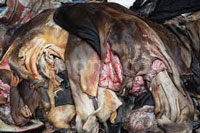
Lower cattle supply set to push up raw hide prices
Ismail Hossain | Sunday, 28 September 2014

Tanners foresee a hike in the prices of rawhides and skins this year for reasons that include lower influx of sacrificial animals and higher demand of made-in-Bangladesh leather products on the international market.
Increasing prices of rawhides and skins on the global market and banks' assurance of providing enough loans for procuring hides in the upcoming season are also among the factors that prompted their predictions.
The leather traders said the industry does not have last year's carried-over stock of rawhides and skins much this year. It means that the tanners have to buy more rawhides of sacrificial animals this year.
There are also high chances of smuggling as Indian traders are more active to get Bangladeshi rawhides during the season, according to intelligence sources.
According to a global commodity price index, Index Mundi, the month-to-month per-pound hide price increased 2.94 per cent in August. They also predicted higher prices this month and the months to come.
Tanners have sought higher amounts of bank credits for the purchase of rawhides and skins in the season centering the holy Muslim fiesta. Banks have already said they would provide Tk 4.92 billion this year. Last year, the amount was Tk 3.7 billion.
Bangladesh Tanners Association (BTA) has set a target of collecting 10 million pieces of rawhide during the upcoming Eid-ul-Azha with a view to meeting the increased global demand.
"We've set a target of collecting 100 million square pieces of hides during the Eid-ul-Azha," said BTA Chairman Md Shahin Ahmed. Last year, they collected 9.5 million pieces.
A senior member of BTA said banks promised to provide them Tk 4.92 billion this year. "But nothing is final yet. There may be a meeting very soon."
Shahin Ahmed said tanners decided not to fix rawhide prices this time as he claimed global prices, in the meantime, have taken a downturn.
"Whatever the market prices during the Eid, we will buy at that rate," he said.
Meanwhile, ministry of commerce (MoC) sources said a meeting will be held on September 28 at the MoC to fix the procurement prices for rawhide and skin. The BTA president said he will place their argument at the meeting.
Bangladesh Finished Leather, Leather Goods and Footwear Exporters' Association (BFLLFEA) President M Abu Taher said there might not be too much change from last year's situation.
When asked, he said, "Well, it's probable that there would be higher prices this year, but there would be greater number of sacrificial animals also, which may cause the price to be lower."
The BFLLFEA chief said smuggling creates scarcity on the market and he fears that if smuggling is not checked strictly, there might be a huge chance of smuggling of rawhides and skins.
Bangladesh Hide and Skin Merchants Association (BHSMA) president Ali Hossain said they had to purchase rawhides and skins at higher prices than the announced rates last year.
Each year, ahead of Eid-ul-Azha, the industry leaders say, the prices of rawhides would be lower though the prices of leather and leather goods are ever increasing across the world.
Asked why so, Ali Hossain said: "It is not true. The prices of leather and leather goods are always fluctuating."
BHSMA president Ali Hossain also expressed apprehension that the new regime in India is strict about cattle coming in Bangladesh.
Major supply of cattle during Eid-ul Azha comes from India.
Ali Hosain said the rawhide prices usually rise 10 per cent every year during Eid-ul-Azha on the local market.
Per-square-foot price of rawhide was Tk85-90 in Dhaka and Tk75-80 outside Dhaka last year. The price bullock hide was fixed at Tk50-55 per square foot, buffalo hide Tk40-45 and goat Tk40-45.
Almost 50 per cent of the annual rawhides are procured during Eid-ul-Azha, 10 per cent on Eid-ul-Fitr and 2 per cent on Shab-e-Barat, according to the Department of Livestock.
Bangladesh's leather goods sector is gradually emerging as a billion-dollar industry. The estimates say almost 90 per cent of the country's leather and leather goods come from Hazaribagh area in the capital.